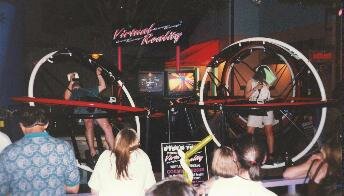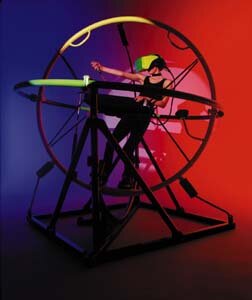
Virtual Reality is up and running at the Walt Disney World Resort in Orlando, Florida. StrayLight Corporation of Warren, New Jersey, recently completed a permanent installation of two CyberTron systems at Pleasure Island, a major attraction on the Disney property. This installation represents the first use of immersive Virtual Reality by Disney. The Pleasure Island venue includes eight discos and numerous other adult-oriented attractions, including the CyberTron Virtual Reality systems. It is the number one destination for after-hours entertainment at Disney. The CyberTron systems have a broad appeal to the thousands of guests at Pleasure Island every night.

Many industry experts feel that the long-term future of theme parks in general will be increasingly virtual. VR attractions have several advantages, for they consume less space and offer interchangeable experiences with little new hardware investment. Perhaps a more compelling force is the lure of interactivity. While most theme park attractions offer their patrons a fixed experience, VR offers unique experiences with each ride. This uniqueness translates into higher repeat business, a fact that is seldom ignored by theme park operators.

The first Disney CyberTron system was installed in November and immediately exceeded revenue projections for the site. Because traffic was so high on the CyberTron, a second system was purchased and installed during early December. Unlike many other Disney attractions, most of the entertainment on Pleasure Island is on a pay-per-play basis. With rides on the CyberTron going for $10 per three minute virtual voyage, the two systems run non-stop from mid-afternoon until 2 a.m. or later.
Although most projections for CyberTron operations target a $5 price per experience, venues such as the Disney resort are often able to achieve significantly higher per-ride revenues.
The CyberTron attraction is based on a gyroscopic motion platform combined with a high resolution head-mounted display and computer system. The Pleasure Island system offers three game experiences developed by StrayLight. The first, Cozmik Debris, is a high-speed thrill ride, offering adventure and rapid-fire arcade-style action. While StrayLight has several new games in production, the current release, Cozmik Debris is unusual because of the wide variety of scenery and action involved. Players rarely stay in the same scene for more than a few seconds and are presented with a variety of unusual events, sounds, and sights along their journey. Although the adventure starts with a pleasant cruise watching dolphins splashing all around, the game quickly turns ominous as one discovers dead bodies floating in the water. Throughout Cozmik Debris the musical scoring is dynamic, reflecting the mood of the moment.
The second CyberTron at the Disney resort offers competitive play, with both CyberTrons being linked over the high-speed Ethernet. In this mode, players are offered both competitive and collaborative gaming scenarios in a new game titled Wing-Nuts. In this game, players master the skill of flying while competing with both another player and computer-generated enemies. Shared experiences such as Wing-Nuts offer higher entertainment value, because players not only compete with the computer, but also interact with their friends, spouses, rivals, and children. This translates into increased CyberTron usage as patrons now queue up in pairs. Pleasure Island CyberTron ticket sales more than doubled when the second system was brought online. The Pleasure Island installation has been a long time in the works, beginning in early 1993.
Disney management approached the issue of immersive virtual reality with extreme caution, citing safety, hygiene, and throughput concerns. The use of a gyro-based motion platform added to the level of scrutiny because of safety concerns. To test the waters, a CyberTron was installed for a one-week evaluation in May 1993. Each day, in addition to the Pleasure Island guests experiencing virtual gaming, different groups of Disney management visited for purposes of inspections, exit interviews, and flow-control optimization. At the end of the test week, CyberTron was deemed to be a desirable attraction for Pleasure Island. Arrangements were then made for the purchase of one system, with an option on a second. Many of the installation and management details were handled by International Equipment Group, of Orlando, Florida, who is very familiar with Disney operations.
Although product safety has always been an important aspect of CyberTron's design, the Disney installation was an important milestone. At the Disney resort, the high level of concern for safety is demonstrated by Disney's rigorous inspection requirements and stringent regulations. Many of the suggestions voiced by the resort's safety engineers during the one-week CyberTron test period were actually incorporated into the final product. This extra bit of design conservatism has contributed to CyberTron's flawless record and ease of obtaining insurance.
The outdoor location of Pleasure Island's CyberTron installation was a significant challenge for StrayLight's engineers. Special environmental control systems were added to the standard CyberTron configuration, so that the system would survive the 30 degree winter nights and the 110 degree summer days. Additional electrical precautions were taken to protect both the guests and equipment. To date, over 2,000 CyberTron machine operating hours have been logged at Pleasure Island, with less than 1 percent downtime.
The Pleasure Island location illustrates only one of CyberTron's applications. StrayLight began its CyberTron shipments in the third quarter of 1993 and now has numerous systems installed in the United States, Latin America, Asian Pacific and Europe.
One of the more intriguing installations is at Blockbuster Entertainment's new Music and Video stores where it is used for promotional purposes. Blockbuster is slated to open over 300 of these new format stores within 18 months and has committed itself to use CyberTron systems as an integral part of these openings.
StrayLight has also shipped CyberTrons to more conventional venues, including arcades, family entertainment centers, and VR centers. The CyberTron has been attractive to owners of these businesses because of its exciting motion platform and variety of games. The CyberTron's $54,000 price tag means that operators can earn paybacks in three to five months. Owners are especially enthusiastic about StrayLight's Silicon Graphics-based architecture, which has clearly addressed the issue of product life span. Silicon Graphics computers are widely recognized as being on the leading edge of virtual reality image generators.
The year 1993 was a tumultuous year for virtual reality. Some observers have raised doubts about the viability of VR in the face of an unending blizzard of media hype. However, many in the industry now see the Disney CyberTron installations and their financial success as proof positive that VR has a promising future in entertainment applications



VR Experience
for Kidney Disease
La Zona SPRITE
3D Ride Film
On Tour
VR Headlines
Michigan State
Homecoming
Copyright (c) 2007
StrayLight Corp.